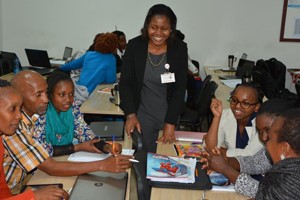A blended learning approach to teaching project management
This story is written by Ms. Jane Kabo, Senior Instructor, School of Nursing and Midwifery, Kenya.
Flipping the classroom-Use of Moodle in the Teaching and Learning of Reproductive Health Nursing: A Teaching Story by Ms. Jane Kabo, Senior Instructor, School of Nursing and Midwifery, Kenya.

"As an instructor for Reproductive Health Nursing, I believe that every student deserves quality teaching and learning processes. Quality teaching and learning experiences enhance students’ achievement. Students come with unique experiences and backgrounds, and therefore it is pertinent to adapt the classroom teaching according to the needs of the learners.
I intentionally choose strategies that maximize students’ learning rather than choosing those, that are easy-to-use. For example, group works are more difficult to organize and manage, as compared to lectures. However, group work is more effective than lectures because it engages students in learning and allows them to take control of their own learning.
The flipped classroom is a pedagogical model which reverses what typically occurs in a class and out of class. Students are first exposed to the material outside of class, in the form of video-based lectures. Subsequently, class-time is used to engage in activities like problem-solving, creating, critiquing, analysis and synthesizing of information. Students take ownership of their learning by using a flipped approach as it keeps them engaged in and outside the classroom. The pedagogy has enabled me to apply more active learning strategies by placing the responsibility for learning upon the student, giving me the role of a facilitator rather than a one-way provider of information. I have moved from instructor-centred to student-centred learning environment while using a flipped approach and my students are able to interact prolifically with each other, the content and the instructor.
Use of Moodle platform while flipping classroom has allowed me to use a variety of methods to engage the learners and to provide online support for my course. Providing a central space on the web where students can access a set of tools and resources anytime anywhere allows them to work flexibly in and out of class. Through the platform, learners ask questions (in and out of the classroom) without feeling embarrassed as their anonymity is maintained. I’m able to access students’ questions, summarise, organise and analyse them, and address them during my face to face lesson. I’m also able to share resources beforehand and engage students in discussion forums. Linking the assignments with the lessons and posting quizzes online has saved me time, postage and paper.
The use of moodle to flip my classroom has supported learning throughout; expanded course offerings and experiences; increased student engagement and motivation; and accelerated learning. From my experience, the technology has improved educational productivity in a number of ways; and students learn faster in and out of class. It reduces the cost of instructional materials and increases efficiency (instructor’s time).
However, there are a few challenges in using flipped classroom and technology. For example, teachers may find it difficult as it takes a lot of time to design higher-order thinking tasks. Students may find it difficult to take charge of their learning especially out of the classroom, and some students are not tech-savvy and thus they may find it difficult to work online effectively. Some planned strategies may not work well while delivering the course, and thus, the teacher needs to rethink and redesign course as per students’ needs.
In conclusion, applying the flipped philosophy has enabled me to adopt a teaching approach that allows me to adapt, in the online environment, the strategies that I use in face-to-face classes. The benefits of the flipped classroom model outweigh the challenges. The implementation of the model becomes easier over time. Moreover, it equips students with skills required in a changing technology landscape and instructors to need to integrate knowledge, instructional practices, and technologies."


